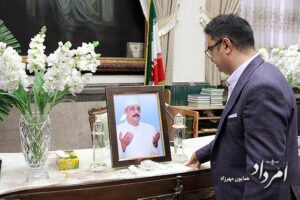The kingdom of Elam is an integral part of the civilization of the Iranian plateau, and what is left of that culture is considered a part of Iran’s precious heritage. The artifacts of the Elam civilization kept in the world’s museums prove ancient Iran’s art, knowledge, technology, and rich history. The “Sitting Cow Silver Statue” is one of hundreds of works that show the brilliant civilization of Elam as it was.
The statue of a sitting cow is a beautiful work from the Nia-Elamite period. Archaeologists divide the history of Elam into several periods, one of which is between 3200 and 2700 BC and is named “Niya-Elamite.” During this critical period, notable works were done by the hands of Elamite craftsmen, some of which have been pulled out of the soil and are scattered all over the famous museums of the world, reminding them of the great civilization of the Iranian plateau.
The silver statue of a sitting cow has a head and hands like a cow (a sacred animal among ancient tribes) and a human body. This figure, found in the southwest of Iran, is symbolic and refers to the beliefs of the Elamites. It is made of silver and shows how advanced and masterful the Elamites were in the metalworking industry. The statue’s height is more than 16 cm, and it was created between 2900 and 3100 BC, in Susa.
A beast made with a human body is holding a tall cup between its two hands. The body of the cup does not have an array, except that the parallel lines make the bottom of the cup more prominent, and its opening is made with similar lines and a folded opening. A small straw in the cup determines its use as a drinking cup. But the garment on the cow’s human body is designed with straight, simple, but eye-catching patterns. Lines seen on the garment are similar to dents of a pinnacle. It is believed that the artist wanted to show the status of the statue’s clothes, maybe because it was used in a religious or royal ceremony.
The animal’s horns and big eyes are masterfully carved, and the depiction shows the cow’s face in its natural form without any exaggeration. In the eyes of the Elamites, the combination of figures with animal heads and human bodies was very symbolic, and there are other examples. Maybe in this way, they wanted to show the superhuman power of their gods. The fact that such figures were used in shrines or the royal court had an interpretation that the gods had entrusted part of their power to the Elamite king.
However, many innovations can be seen in the construction and technology of Elamite artisans in 3000 BC. Making a cylindrical chip with an inscription on it is just an example of their innovations. The ceramics created by the Elamites also had an innovative feature. The silver statue of the sitting cow is also associated with many innovations and novelties not seen in other civilizations in that period. Therefore, it should be considered very valuable from an artistic point of view.
The silver statue of the sitting cow is now kept in the Metropolitan Museum of New York, USA.










